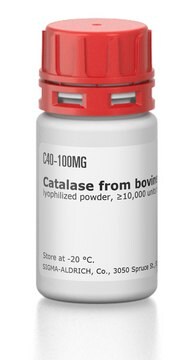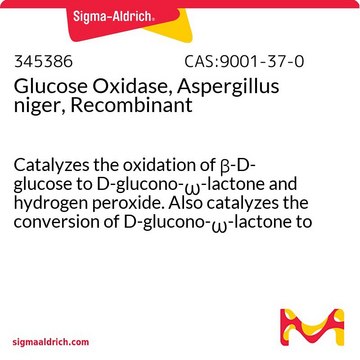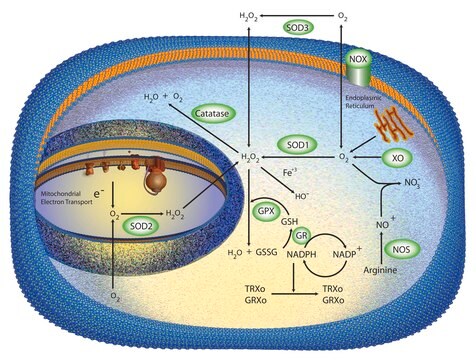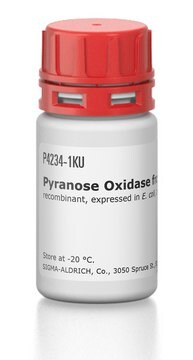C9322
Catalase from bovine liver
lyophilized powder, 2,000-5,000 units/mg protein
Sinonimo/i:
H2O2:H2O2 oxidoreductase
About This Item
Prodotti consigliati
Origine biologica
bovine liver
Stato
lyophilized powder
Attività specifica
2,000-5,000 units/mg protein
PM
tetramer ~250 kDa
Punto isoelettrico
5.4
N° accesso UniProt
Condizioni di spedizione
wet ice
Temperatura di conservazione
−20°C
Stringa SMILE
O(CC)C(=O)c1ccc(cc1)O
InChI
1S/C9H10O3/c1-2-12-9(11)7-3-5-8(10)6-4-7/h3-6,10H,2H2,1H3
NUVBSKCKDOMJSU-UHFFFAOYSA-N
Informazioni sul gene
cow ... CAT(280743)
Cerchi prodotti simili? Visita Guida al confronto tra prodotti
Descrizione generale
Catalase from bovine liver is a tetramer consisting of 4 equal subunits each with a 60 kDa molecular weight. Each of these subunits contains iron bound to a protoheme IX group. The enzyme will also strongly bind to NADP, where NADP and the heme group are within 13.7 angstroms.
Applicazioni
Catalase from bovine liver may be used:
- to prepare H2O2-O2 based biocathode for applications in glucose biofuel cells
- to study the kinetic properties and storage stability of catalase immobilized on to florisil
- in glutathione-mediated superoxide generation in an aqueous solution
Azioni biochim/fisiol
Avvertenza
Definizione di unità
Nota sulla preparazione
The enzyme is soluble in 50 mM potassium phosphate buffer at 1 mg/mL and pH 7.0.
Stoccaggio e stabilità
Inibitore
Avvertenze
Danger
Indicazioni di pericolo
Consigli di prudenza
Classi di pericolo
Resp. Sens. 1
Codice della classe di stoccaggio
11 - Combustible Solids
Classe di pericolosità dell'acqua (WGK)
WGK 1
Punto d’infiammabilità (°F)
Not applicable
Punto d’infiammabilità (°C)
Not applicable
Dispositivi di protezione individuale
Eyeshields, Gloves, type N95 (US)
Scegli una delle versioni più recenti:
Possiedi già questo prodotto?
I documenti relativi ai prodotti acquistati recentemente sono disponibili nell’Archivio dei documenti.
I clienti hanno visto anche
Articoli
Oxidative stress is mediated, in part, by reactive oxygen species produced by multiple cellular processes and controlled by cellular antioxidant mechanisms such as enzymatic scavengers or antioxidant modulators. Free radicals, such as reactive oxygen species, cause cellular damage via cellular.
Protocolli
This procedure may be used for all Catalase products.
Il team dei nostri ricercatori vanta grande esperienza in tutte le aree della ricerca quali Life Science, scienza dei materiali, sintesi chimica, cromatografia, discipline analitiche, ecc..
Contatta l'Assistenza Tecnica.












